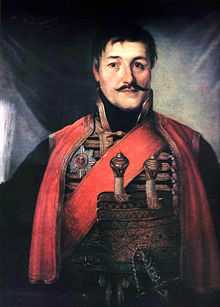Karađorđe
| ||||||||||||||||||||||||||||||||||||||
Đorđe Petrović OSA (Serbian Cyrillic: Ђорђе Петровић, Serbian pronunciation: [d͡ʑôːrd͡ʑe pětroʋit͡ɕ], Anglicized: George Petrovich), known as Karađorđe (Карађорђе, [kârad͡ʑoːrd͡ʑe], Black George[a]; 16 November 1768 – 24 July 1817), founded modern Serbia as the elected leader of the First Serbian Uprising (part of the Serbian Revolution) that aimed at liberating Serbia from the Ottoman Empire (1804–1813); he personally led armies against the Ottomans in several battles, which resulted in a short-lived state which he would administer as Grand Leader (Veliki Vožd) from 14 February 1804 to 21 September 1813, alongside the newly founded People's Assembly and the Governing Council, simulating a wholly functional state government in war-time.
Born into a poor family who were pig farmers [1] in Šumadija, at the time part of the Sanjak of Smederevo (modern central Serbia), Đorđe began working as a servant for affluent Serbs and Turks, but after having killed a local Ottoman aga (lord), his family fled across the Sava into the Military Frontier, a Habsburg-controlled area. He rose to prominence in the Austrian army, participating in Koča's frontier rebellion. He received a medal of honour for his efforts, and when the Austrian army was forced to retreat, and the Ottomans re-occupied Šumadija, he joined the hajduks (brigands, rebels). He commanded a unit and fought the Ottomans until 1794, when he returned to his family.
In the following years the local janissaries grew stronger and seized the sanjak from the Sultan, imposing greater taxes and perpetrating violence against the population; as the janissaries feared the Sultan's retaliation as a possible task given to the Serbs, they executed hundreds of prominent Serbs in what would be known as the Slaughter of the Dukes (1804). Some 300 nobility assembled and elected Karađorđe as leader; by the end of the year the janissaries were defeated, and the Sultan praised the Serbs. However, when the pasha arrived in Serbia to take over the governance, he was killed. The struggle continued as a wide-scale revolt, the First Serbian Uprising, in which several battles were successfully fought against the Ottomans; a government was established, and Karađorđe abolished feudalism.
After the suppression of activities in 1813, Karađorđe and other leaders went into exile, while in 1815 Miloš Obrenović, a fellow rebel leader, initiated the Second Serbian Uprising. The second uprising ended in 1817, when Obrenović signed a treaty with the Ottomans and became the Prince of Serbia. Obrenović (who saw a threat in the possible return of popular Petrović) and the Ottomans (who despised him and feared more fighting) conspired and planned the assassination of Karađorđe. When Karađorđe returned in 1817 to start yet another uprising, he was deceived by a friend and killed; his head was sent to Constantinople and Obrenović retained his leadership.
Karađorđe founded the House of Karađorđević, the Serbian royal family, which would later gain the Serbian crown after the deposing of the rival House of Obrenović.
| Monarchical styles of Karađorđe Petrović, Grand Vožd of Serbia | |
|---|---|
 | |
| Reference style | His Highness |
| Spoken style | Your Highness |
| Alternative style | Sir |
Origin
He was born on November 3 [O.S. November 16] 1768 in the village of Viševac,[2] then part of the Ottoman Empire (today's Rača municipality, Šumadija District), one of five children (alongside brothers Marko and Marinko, and sisters Marija and Milica) to father Petar (or Petronije) Jovanović and mother Marica née Živković (from Masloševo, in Stragari). Karađorđe's slava was Saint Clement.[2]
Karađorđe's paternal ancestors hailed from Vasojevići (Montenegro), and had left for Serbia; on the way, they lived in Mačitevo (in Suva Reka), from where grandfather Jovan moved to Viševac, while Jovan's brother Radak moved to Mramorac.[2][3] The Vasojevići clan claimed descent from Stephen Constantine of the Nemanjić dynasty (that ruled Medieval Serbia, 1166–1371).[3] The Vasojevići were proud of Karađorđe and saw him as their sprout.[4] Serbian historiography accept the theory that Karađorđe's ancestors came from Vasojevići, although there some other unproven theories (see Karađorđević dynasty).[5]
Early life
His family was poor, their situation progressed as Karađorđe began working for affluent Serbs and Turks. He and his father worked for a Fazlibaša, an Albanian who had enriched himself from robbing merchants, and who had bought a big house in Smederevska Palanka. There, Karađorđe came into conflict with some local Turks; Fazlibaša protected Karađorđe and punished these Turks. His family then moved to Zagorica, where he married Jelena Jovanović, from Masloševo, in 1785. Jelena is thought to have come from a wealthy background, thus her family didn't accept his marriage proposal. Karađorđe took her and married her without the parents' consent. In Zagorica, he was angered by the violent behaviour of a Turk, whom he then killed, after which he hid at Fazlibaša's house until some time when he could return home. However, he did not have peace at home as people started talking about his murder, thus Karađorđe saw crossing the Sava river, into Syrmia, in the Austrian-held Military Frontier, as the only chance of saving his family. What happens next is a matter of debate.[6] The family left the home in secrecy, though on the way his father felt regret and wished to turn back, which would risk the family's survival; for this, Karađorđe cold-heartedly killed him, and continued into Syrmia, arriving in ca. 1787.
Karađorđe then lived and worked in the Krušedol monastery.
Austrian-Turkish War
At the end of the Austro-Turkish War, 1787, amid Koča's frontier revolt, Karađorđe enrolled in the Freikorps of the Austrian Army, fighting against the Turks.[7] He took part in the botched attack on Belgrade, and fought in western and southern Serbia, where he gained military experience.[7] In the mid-1791, peace was concluded, and Karađorđe received a medal of honour. He then joined the Hajduks, where he led a large band. The decline of Hajduks came in 1793-4, at which point Karađorđe rejoined his family, living peacefully in Topola. He began working as a livestock merchant, trading over the border with the Habsburg monarchy.[7]
War against the Janissaries

Oppression against Serbs significantly increased in the beginning of 19th century when janissary leaders, the dahis, rebelled against the Sultan and seized the rule of the Sanjak of Smederevo. It culminated in January and February 1804, when dahis prepared executions of popular leaders, gentry, priests, former rebels and wealthy traders, dubbed the Slaughter of the Dukes, in which some 150 of the most notable Serbs were killed.[8] Karađorđe, among few other notable people who would later initiate the Serb Uprising, survived the assassinations.
As a response to the executions, the Serbian population without a central figure took measures of self-defence, and spontaneously attacked the jannisaries.[8] Prota Mateja and several other leaders had organized military detachments that engaged the dahis in Valjevo.[9] on 14 February 1804, 300 notables met in Orašac, Aranđelovac where Karađorđe was chosen as the undisputed leader.[8] When Prota Mateja heard of this, he urged all Serb leaders to resist the dahis and the Ottoman authorities,[9] Mateja was appointed deputy-commander of Valjevo, and later acted as diplomat to Russia, Austria, Bucharest and Constantinople. By the spring of 1804, Karađorđe had 30,000 combat-ready men under his wing.[8] After May 1804, Karađorđe was titled Supreme Voivode.[8]
The Serbians managed to quickly organize a widespread revolt, under the pretext of liberation from the dahis, Karađorđe was successful in this, he terminated feudalism in the liberated areas of Serbia and installed his military commanders and local leaders as governors of nahis (administrative units), the dahis who refused to leave were captured and executed after the Serbian liberation of Belgrade.
First Serbian Uprising
In March 1805, Karađorđe was officially appointed Military leader of Serbia, the self-proclaimed Vožd (old Serbian for vođa, "leader"). The Ottoman government welcomed the rebellion against the dahis and decided to install a new governor in Belgrade. Karađorđe, after tasting the fruits of liberty, decided not to let the new pasha enter the liberated area and defeated his army in the Battle of Ivankovac of 1805. This battle signified a turn of events, since the uprising was not a rebellion against the dahi terror anymore, but a war of liberation against the Ottoman rule. Karađorđe founded the Narodna Skupština (People's Assembly) and Praviteljstvujušči Sovjet (Governing Council) whose decree was drafted by writer and jurist Teodor Filipović (a.k.a. Božidar Grujović).
"Therefore, dear Serb brothers...now when it's only up to us, take an example from those peoples who foster unity and order, for they have become mighty and prosperous; offer advises to each other, as the priests do, when they teach their flock: teach them the words of Christ, the ones which say: As I have loved you, so you also should love one another. Not so much by words, but by your deeds... by doing so, the end of our quest will bring out the old glory of Serbia to show, who we indeed are: the children of our glorious and brave ancestors"
The revolutionaries liberated territories after achieving several victories, at Mišar, at Deligrad and at Belgrade, in 1806; and at Šabac and at Užice in 1807. In 1806-1807 a Serbian envoy to the Ottoman government in Constantinople, Peter Ichko, managed to obtain a favourable Ichko's Peace. However, Karađorđe disavowed the agreement and aligned with the Russian Empire in a war against the Ottoman Empire.
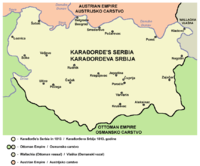

In 1808, Selim III and his successor Mustafa IV were both deposed and killed by Mahmud II. In midst of this political crisis, the Ottomans were willing to offer the Serbs a wide autonomy, however, the discussions led to no agreement between the two, as they couldn't agree on the exact boundaries of Serbia.[10] Karađorđe now declared himself hereditary supreme leader of Serbia, although he agreed to act in cooperation with the governing council, which was to also be the supreme court.[11] When the Ottoman-Russian War broke out in 1809, he was prepared to support Russia, the cooperation was, however, ineffective.[11] Karađorđe launched a successful offensive in Novi Pazar, but was subsequently defeated at Battle of Čegar.[11] In August 1809, an Ottoman army marched on Belgrade, prompting a mass exodus of people across the Danube, among them Russian agent Radofinikin.[10] Facing disaster, Karađorđe appealed to the Habsburgs and Napoleon, with no success.[10] At this point, the Serb rebels were on the defensive, their aim was to hold the territories and not make further gains.[10][11]
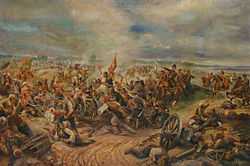
In July 1810, Russian troops arrived in Serbia for the second time, this time some military cooperation followed; weapons, ammunition, and medical supplies were sent, and Marshal M. I. Kutuzov, the great commander, participated in the planning of joint actions.[11] The Russian assistance gave hope for a Serb victory, however, events in Europe were in the way.[11] Russia, faced with a French invasion, wished to sign definitive peace treaty, and acted against the interest of Serbia.[11] The Serbs were never informed of the negotiations; they learned the final terms from the Ottomans.[11] This, second Russian withdrawal, came at the height of Karađorđe's personal power, and rise of Serb expectations.[11] The negotiations that led to the Treaty of Bucharest (1812), had Article 8, dealing with the Serbs; It was agreed that Serb fortifications were to be destroyed, unless of value to the Ottomans, pre-1804 Ottoman installations were to be reoccupied and garrisoned by Ottoman troops, in return the Porte promised general amnesty and certain autonomous rights; The Serbs were to control "the administration of their own affairs" and the collection and delivery of a fixed tribute.[11] The reactions in Serbia was strong, the reoccupation of fortresses and cities was of particular concern and fearful reprisals were expected.[11]
In 1812, threatened by Napoleon's French Empire, Russia had to quickly sign a peace treaty with the Ottomans. In 1813, the Ottoman Empire launched a big assault on Serbia taking land all up to the rivers Morava and the river Drina, and Karađorđe, along with other rebel leaders, fled to the Austrian Empire on 21 September 1813.
Exile, Death and aftermath
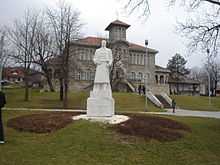
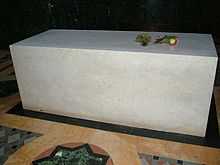
After some time, Karađorđe emigrated to Bessarabia, where he joined the Greek national liberation movement Filiki Eteria, becoming an active member.[12] The Greeks were primarily interested in using the Serbian lands as base of the Greek operations.[13] Miloš Obrenović was fully uncooperative.[10]
On July 24, 1817, days after he secretly crossed into Serbia to try to spearhead a new uprising, Karađorđe was assassinated in Radovanjski Lug by the men of Miloš Obrenović,[12] Vujica Vulićević and Nikola Novaković. This happened on the orders of the Ottomans, who feared the possibility of a new uprising, while Miloš feared competition by the enormously popular Karađorđe. Some historians have speculated that Karađorđe had no political ambitions and simply wanted to return home from exile, and informed Obrenović of this in advance, however, Obrenović did not believe him and had him killed. The assassination marked the beginning of the Obrenović—Karađorđević feud, that ended in 1903.
Looks, personality and legacy
Vuk Karadžić, a contemporary, wrote about Karađorđe, Djordje Petrović, known as Kara or Black Djordje(Georg), was born between 1760 and 1770 in county of Kragujevac, in village called Viševac, as son of one of peasants by the name Petronije, and in his early youth he went with his partnes in hills near Topola. He said that he was tall, physically strong and heavy shouldered.,,He was an unusual man. He would sit sometimes for days, not talking to anybody, and bitning his fingernails. When somebody would want to talk to him, he would turn his head away and would not say a word. When her would drink a little he would become more talkative.He was tall man, wide shoulders, with big nose Not a single man in the Serbian revolutionary army could go against him in direct combat; only Stanoje Glavaš, the initial choice of Grand Leader, was considered physically stronger. He had a big nose, dark hair, and his left hand was dislocated at the palm, though it did not stop him from shooting his rifle with great precision, He would jump from a horse, because he liked to fight as infantryman. Aldo his left hand was dislocated from some wound from days as Hajduk,he still was formidable in use of a rifle.
He was said to be a strict and harsh man, a military man and strategical genius, not necessarily fit for politics and administration.,,His justice was harsh and cruel... He had a drinking habit, resulting in a somewhat high-pitched voice when under influence., He had high-pitched voice...
It is alleged that he killed his own brother and father. His brother allegedly raped a young girl; Karađorđe, seeing this as unforgivable, he killed him. ,,He liked order and discipline. He would let things go on their way, until it would not go any further.Than his justice would be harsh and terrible. Hiding behind his name, his only brother allowed himself many things, and Đorđe went on with this for a long. But when his brother raped some girl, and her cousins complained loudly that because of those things Rebelin started on the first place against the Turks, Karadjorjde became so mad, that he hanged his only brother on his house door. He than forbid his mother to cry... His father allegedly held the family back at the time of Austrian retreat, unconcerned by possibly Ottoman retribution against the family, so Karađorđe killed him. During time of peace, he worked the field, as common folk, and once broke his medal. He did not give his daughter any privileges during his term as Grand Leader, making her work as everybody else.
Besides his harsh and emotional side, he was friendly, liked to joke and could take a joke, but it had a limit. He was praised by Napoleon for his military skill, and Petar Petrović-Njegoš wrote abut him, comparing him to Napoleon, Wellington and Kutuzov, three of the greatest generals of his time. Pushkin made a song about him to his daughter and Hegel also wrote about him.
Awards
See also
| Wikimedia Commons has media related to Karađorđe Petrović. |
- The Life and Deeds of the Immortal Vožd Karađorđe, 1911 silent film
- Karađorđević family tree
Annotations
- ^ Nickname: George Petrović was known in Serbian as Karađorđe and Crni Đorđe (Serbian Cyrillic: Црни Ђорђе, Angl.Karageorge, Black George, Turkish: Kara Yorgi), a nickname that the Ottomans gave him because of his bellicosity and commoner background, alternatively for the black suits that he wore and was easily recognizable by ("kara" is black in Turkish).
References
- ↑ http://www.nytimes.com/books/first/s/sudetic-blood.html
- ↑ 2.0 2.1 2.2 Bogdan Popović, Jovan Skerlić (1932). Srpski književni glasnik, Volumes 35-36. p. 282.
- ↑ 3.0 3.1 R-J. V. Vesović, 1935, "Pleme Vasojevići", Državna Štampa u Sarajevu, Sarajevo
- ↑ Pregled, Volume 9 (in Serbian). Nova tiskara Vrček i dr. 1933.
Васојевићи нарочито радо причају о војводама Србије који су имали везе са њиховим племеном или из њега старином потичу. Говоре често о Карађорђу, зову га Карађоко и сматрају га као свој изданак.
- ↑ "Srpsko Nasledje". Srpsko Nasledje. Retrieved 15 August 2012.
- ↑ http://www.novosti.rs/dodatni_sadrzaj/clanci.119.html:276202-Bekstvo-iz-Srbije. Missing or empty
|title=(help) - ↑ 7.0 7.1 7.2 Jelavich 1983, p. 200
- ↑ 8.0 8.1 8.2 8.3 8.4 Jelavich 1983, p. 196
- ↑ 9.0 9.1 North American Society for Serbian Studies 1995, p. 137
- ↑ 10.0 10.1 10.2 10.3 10.4 Jelavich 1983, p. 201
- ↑ 11.0 11.1 11.2 11.3 11.4 11.5 11.6 11.7 11.8 11.9 11.10 Charles Jelavich; Barbara Jelavich (1977). The Establishment of the Balkan National States: 1804-1920. University of Washington Press. pp. 34–. ISBN 978-0-295-80360-9.
- ↑ 12.0 12.1 Jelavich 1983, p. 207
- ↑ Jelavich 1983, p. 240
Sources
- Biographies
- Vukićević, Milenko M. (1912). Karađorđe (in Serbian) 2. Belgrade: Državna štamparija Kraljevine Srbije.
- Dimitrijević, Kosta (1971). Vožd Karađorđe (in Serbian). Industrodidakta.
- Ljušić, Radoš (2003). Vožd Karađorđe: biografija (in Serbian). Завод за уџбенике и наставна средства. ISBN 978-86-17-10705-3.
- History books
- Jelavich, Barbara (1983). History of the Balkans:. Cambridge University Press. ISBN 978-0-521-27458-6.
- Milan Đ Milićević; Jovan Radulović (2005). Kneževina Srbija. Book & Marso.
- Journals
- North American Society for Serbian Studies (1995). Serbian Studies 9–10. North American Society for Serbian Studies.
- Карађорђе истина и мит, Радош Љушић, страна број 1 (Serbian)
- Template:Vuka Karadžić-Serbian history of our time
| Karađorđe Born: November 1768 Died: 24 July 1817 | ||
| Regnal titles | ||
|---|---|---|
| Preceded by Title created |
Grand Vožd of Serbia 14 February 1804 – 21 September 1813 |
Succeeded by Miloš Obrenović I as Prince of Serbia |
| Political offices | ||
| Preceded by Jakov Nenadović |
President of the Administering Council 22 January 1811 – 3 October 1813 |
Succeeded by Mladen Milovanović |
| ||||||||||||||||||||||||||||||||||||||
| ||||||||||
| ||||||||||||||||||||||||||||||||||||||||||||||
| ||||||||||||||||||||||||||||||||||||||||||||||||||||||||||||||||||||||||||||||||||||||||||||||
|
